The month of February has come again tomorrow. One of the brightest in the history of Bangladesh is February which is the month of language, the month of remembrance of self-sacrifice and at the same time the month of pride and courage. While remembering the memory of the great language martyrs and thinking of paying homage to them, the portrait of Shaheed Minar came to mind. Many people are not aware that today's Shaheed Minar is not the first. The Shaheed Minar was built several times before. Today's article revolves around the journey of this great monument from the past to the present, witnessing important history.
On 21 February 1952, tear gas and bullets were fired at a procession demanding to make Bengali the state language. The next day, on 22 February, the protesters were also shot. Rafiq, Salam, Barkat, Awal, Shafiur and many others were martyred. The central Shaheed Minar, which is now located inside Dhaka University (adjacent to the Mathematics Department of Dhaka University) near Dhaka Medical College, is a symbol of respect and reverence for their great sacrifices. Its architect is Hamidur Rahman. However, this Shaheed Minar was not built in the first place. On the contrary, judging in chronological order, the monument was built several times before it.
The first built Shaheed Minar
After the incident on 21st February, it was decided to build the first Shaheed Minar on 22nd February. Work started on 23rd February. Despite the curfew, work resumed on the afternoon of February 23. The Shaheed Minar was built by the students of Dhaka Medical College. After working all night on the design of Badrul Alam and Saeed Haider, the construction work of Shaheed Minar was completed. This work was supervised by GS Sharfuddin and assisted by two masons.
The memorial was erected by the students at the east end of Shed No. 12 of the Student Hostel (Barracks) in the south-east corner of the present Shaheed Minar premises. The ten and a half feet high (3.2 meters) and 6 feet (1.6 meters) wide Shaheed Minar was built with bricks and sand kept for the renovation and expansion of the Medical College and cement brought from the warehouse of Piyaru Sardar in Old Dhaka. Piyaru Sardar was one of the Panchayat Sardars of old Dhaka. After dawn, it was covered with cloth and a handwritten piece of paper was written on the front - 'Martyr's Memorial'.
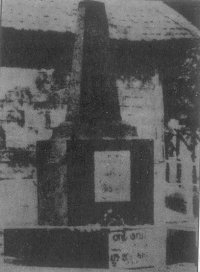
First built Shaheed Minar Dhaka (Pakistani police demolished after 3 days)
The Shaheed Minar was inaugurated unofficially on the morning of 24th February by Mahbubur Rahman, the father of Shaheed Shafiur on 22nd February. In the meantime, the news of Shaheed Minar was published in the daily Azad under the headline 'In memory of Shaheed Bir'. Abul Kalam Shamsuddin, editor of the daily Azad, inaugurated the Shaheed Minar on February 26. In the afternoon, police cordoned off the Medical College Hostel area and demolished the first Shaheed Minar. Later a memorial was also erected at Dhaka College. But even that was demolished on the orders of the government. Some small monuments were built all over the country.
Many claim that the first Shaheed Minar was built in Rajshahi with bricks and mud before the first Shaheed Minar was built in Dhaka. It was made by the students of Rajshahi Government College. After waking up all night and constructing the Shaheed Minar, when they went out for picketing in the morning, the police came and demolished the monument. The footsteps of this poem were inscribed on the monument: In the end, whatever the soul does, there is no loss, no loss. ”
According to Golam Arif Tipu, who was present at the construction of the Shaheed Minar, the decision to build the Shaheed Minar was taken on 21st February and it was completed overnight. Although they did not make any attempt to prove that this is the first Shaheed Minar, he opined that the Shaheed Minar in Rajshahi was built before Dhaka.
Shaheed Minar built between 1953-1954
The following year, on 21st February, Martyrs' Day was celebrated all over the country and a similar portrait of the former Shaheed Minar was made in the same place with red paper. It is then covered with a black cloth. From there, the students go out for the first time in the morning ferry, this is how the morning ferry starts. The following year (1954), Prabhatferi was launched again in the same form on 21st February.
The United Front government came to power on April 3 after gaining a majority in the March 10 elections of the same year. At the May 9 session, they announced that, in accordance with their 21 points, the Shaheed Minar would be rebuilt and that February 21 would be called 'Martyr's Day'. But they failed to implement the decision, and on May 30, the government collapsed. However, a small monument was erected in 1954, inaugurated by Natyaguru Nurul Momen. Large scale construction of Shaheed Minar started in 1956.
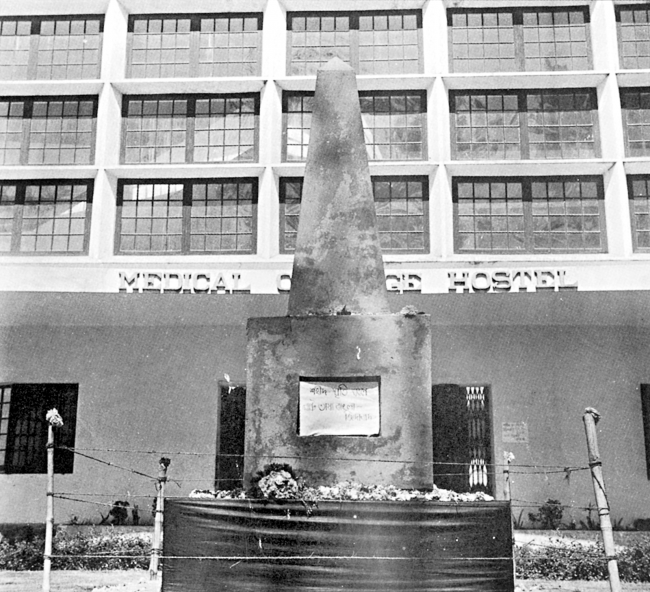
The second Shaheed Minar built in 1954
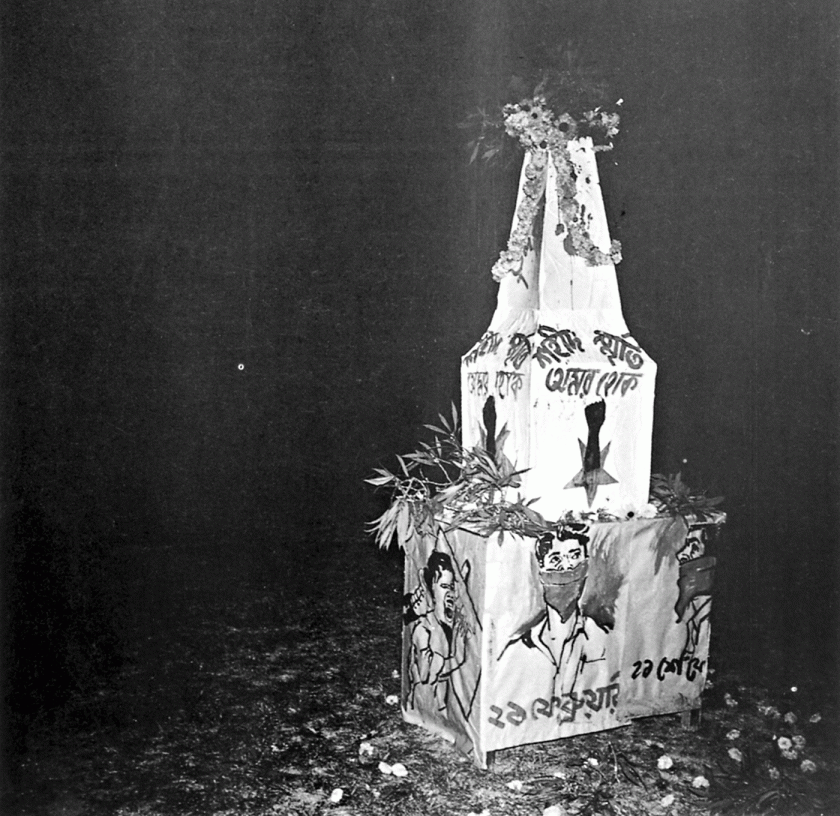
The Shaheed Minar, built in 1953 at Curzon Hall
Shaheed Minar (1983-1981)
In 1958, when Abul Hossain was the Chief Minister, the Minister of Public Works, Abdus Salam Khan, selected a site on the premises of Dhaka Medical College Hostel for the construction of Shaheed Minar. Later, a minister was supposed to lay the foundation stone of the Shaheed Minar, but he did not do so in the face of huge objections from the people.
In 1958, A.K. Martyr's Day was celebrated all over East Pakistan at the initiative of Fazlul Haque and the United Front led by the Awami League and this accelerated the construction process of the Shaheed Minar. It was planned to build a Shaheed Minar complex with a large area in front of the hostel of Dhaka Medical College. Hamidur Rahman and Novera Ahmed were given the responsibility of architectural design. Construction began on November 9, 1956. Construction was delayed due to martial law.
In 1962, a committee headed by the then Governor of East Pakistan, Azam Khan, wrote a letter to the Vice-Chancellor of Dhaka University asking him to change the design of the Shaheed Minar and finish it briefly. The monument of Shaheed Minar was inaugurated on 21st February 1983 by Hasina Begum, mother of Bahashahid Barkat. Although the work of the entire complex has not been completed yet.
The plan to build the Shaheed Minar with Hamidur Rahman and Novera Ahmed was to indicate a semi-circular column on the central altar pointing to the mother and her fallen children. Yellow and dark blue glass was supposed to be placed in the columns to indicate the reflection of sunlight in the eyes. The floor was supposed to be made of marble so that the shadows of these columns could be seen to move over time.
The history of the language movement was to be mentioned in a mural of 1500 square feet (140 square meters) in the basement below the altar. A railing with a Bengali inscription was to be erected in front of the monument. And red and black were to draw two footprints, indicating two different factions in opposition to the language movement. An eye-shaped fountain, a museum and a library were also planned by Hamidur Rahman.
Hamidur Rahman designed the Shaheed Minar in such a way that it could withstand the climate of this tropical region. Prior to the imposition of martial law, foundations, altars, columns, railings, footprints, murals and other works were completed. When it was inaugurated in 1973, most of Hamidur Rahman's designs were incomplete.
During Operation Searchlight, a genocidal operation carried out on March 25, 1971, the Pakistani invaders damaged the Shaheed Minar and demolished it, leaving a signboard with the inscription 'Mosque' on it.
The present Shaheed Minar
After the independence of Bangladesh, a committee was formed in 1972 under the leadership of the then President Abu Saeed Chowdhury to rebuild the Shaheed Minar. They want to get the job done quickly based on the 1973 design. Then in 1986 a new design was approved for the Shaheed Minar although it was not fully implemented.
According to the new design, four small and one large column on a 1,500-square-foot basis indicate the mother and her fallen children. There will be a red sun behind it. These were made of bright marble. White color will be used in the stairs which will bring a white majestic beauty. Poems of famous poets will be written on the wall.
But due to the rush, the plan could not be implemented properly. During construction, the length of the columns is less than the planned length and the head of the main column is made by bending more than planned. Besides, the work of various parts of the minaret was not done properly. Then in the eighties the chief architect S.H.M. Under the leadership of Abul Bashar, the area of Shaheed Minar was expanded to quadrangle from triangle. In this new plan, the mural plan of Hamidur Rahman's design was canceled and the basement part was closed.
The Shaheed Minar received its present form in 1983, with marble stones being used on some of the damaged parts of the walls. According to the plan of that time, there was talk of building a museum and library in the area of Shaheed Minar. Then on August 25, 2010, the High Court issued nine directions for the management and maintenance of the Shaheed Minar and directed the construction of a museum and library. The height of the present Shaheed Minar is 14 meters (48 feet).
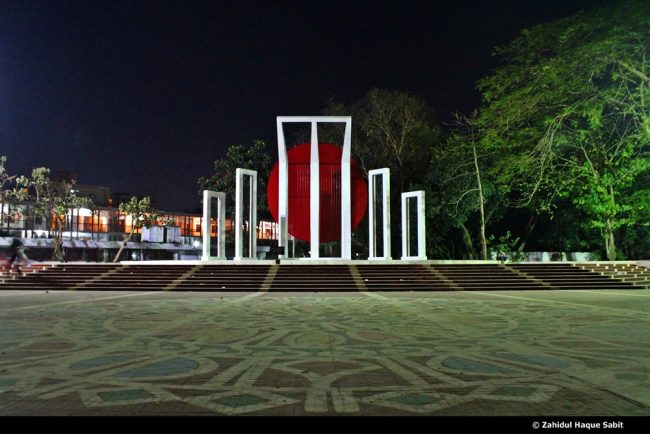
Central Shaheed Minar
Although various arrangements were seen around the Shaheed Minar on 21st February, it is neglected for most of the year. Apart from this, more Shaheed Minar has been built in the country and abroad in the dignity and respect of language martyrs. Some of the notable ones are:
Bangladesh's tallest Shaheed Minar at Jahangirnagar University, Shaheed Minar at Rajshahi University, Shaheed Minar at Patuakhali University of Science and Technology, Khulna University of Engineering and Technology, Bangabandhu Krishi University, Shaheed Minar in Calcutta, India The pillar was later renamed the Shaheed Minar), the Shaheed Minar in Altab Ali Park, East London, the Shaheed Minar in Westwood, Oldham, etc.
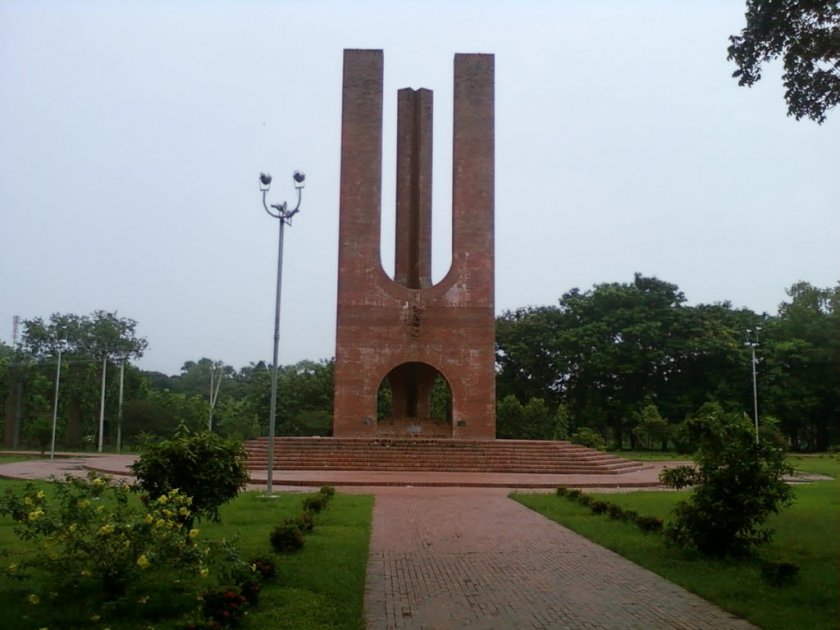
Bangladesh's tallest Shaheed Minar (Jahangirnagar University)
The great language of Shaheed Minar is a symbol of self-sacrifice, patriotism and heroism of the martyrs. Its maintenance is the responsibility of the government as well as the citizens as well as us. As long as the Bengali language and Bangaliana survive, the memory of the great language martyrs will remain immortal among us. Therefore, it is desirable that this respect should always be maintained, not just revolving around the month of February.
May the memory of the great language martyrs in the history of Bengal and Bangladesh be immortal, immortal - and let the Shaheed Minar, the symbol of humble reverence, proclaim it with pride forever.











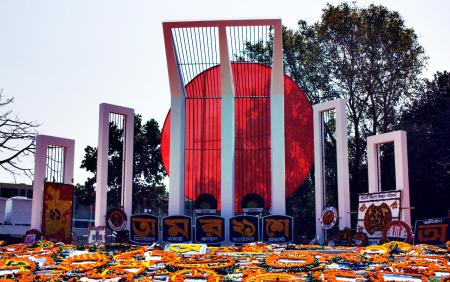
Comments (0)